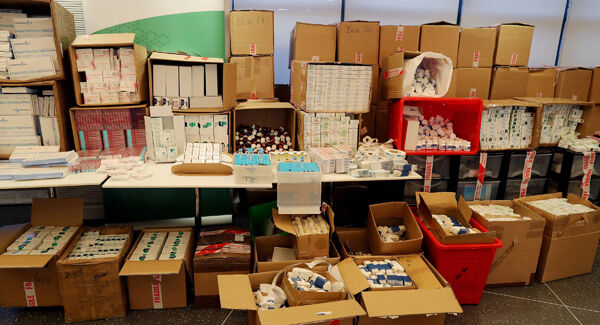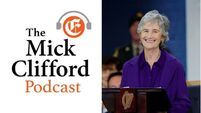Why is the demand for steroids rising among young people?

Nearly 450,000 steroids were seized in the first eight months of the year, despite warnings over their ingredients and health side-effects. Why are so many young people using them, asks
Illegal steroid abuse by users wanting to build muscle quicker and enhance performance has increased exponentially in just four years, with the number of drugs seized rising from 19,000 in 2013 to more than 443,000 this year.
The Health Products Regulatory Authority (HPRA), working in conjunction with gardaí and customs officials, seized 443,000 tablets, capsules, and vials in the first eight months of the year — increasing more than 300% on 2016 when 109,000 were seized.
Anabolic steroids allow users to build muscle and enhance performance much quicker than those relying only on lifting weights and nutrition.
While muscle gain will be much quicker for users, the side-effects range from damage to internal organs such as the heart and liver; hair loss and shrunken testes in men; and facial hair gain and the changing of the appearance of sex organs in women.
The explosion in popularity of health and fitness in the past decade has led to some gym users turning
to steroids to significantly enhance their physiques.
However, anecdotal evidence suggests the precise nature of “cycling” anabolic steroids — which means injecting the drugs for a number of months, before switching to different drugs to combat side effects to organs such as the liver — is not being adhered to, leading to severe health issues.
The HPRA warned that the majority of anabolic steroids containing medicines detained to date in 2017 are in fact falsified — meaning users could be injecting products totally different to what they believe they are using.
The HPRA said: “Such products were illegally manufactured or misrepresented their true source or their distribution chain. Some had a different active ingredient than listed on the package while others did not reveal any active ingredient on analysis.
“This is indicative of illicit manufacturing where standards that are used in the manufacture of legitimate medicines are not applied. This situation poses a direct risk to the health of consumers.”

Cork-based sport and exercise scientist Ainle Ó Cairealláin, a former strength and conditioning coach to the Cork Gaelic football team, said there was a false perception that illegal steroid abuse only took place at the top echelons of sport.
“Steroid use has been around for decades. From the world of bodybuilding, we are used to seeing the images of men and women who put their physical and mental health on the line for the big day on stage. In cycling, the glory of Tour De France victories have been tainted by ever-present revelations of doping.
“To talk about steroid use in such broad terms runs the risk of giving the impression that steroid use is something that only athletes at the top of their game do, something that happens under the supervising eye of a corrupt yet qualified doctor in some state-sponsored lab.
“However there is a problem with steroid use among young people in Ireland today, and it is important to talk about it.”
The managing director of ACLAÍ Health and Performance in Cork City, Mr Ó Cairealláin said many gyms were ignoring the problem of illegal steroid abuse and that they had to be part of the conversation to tackle the explosion in demand.
“Having started ACLAÍ in 2013, and worked with many athletes and coaches over the last 13 years as a strength and conditioning coach, I can see that gyms around the country are turning a blind eye to people who are as young as 18 years old who are accessing and using anabolic steroids in pursuit of what they believe to be the ideal body type,” he said.
“It isn’t under the supervision of a doctor, it isn’t administered in a medical facility, and it certainly isn’t legal or healthy.
“In my mind this raises questions that need to be answered — why are so many young people turning to steroid use in Ireland today? Who is pulling the strings when it comes to promoting this type of drug use? And how can we turn the tide?”
Mr Ó Cairealláin said the abuse of anabolic steroids ties in with mental health, especially among young people.
“Young people are taking their lives due to depression, anxiety, lack of self-confidence, lack of hope, and lack of self-worth and self-love every single day of the week.
“When I think about steroid use in Ireland among young people, especially young males — who are also most at risk from suicide and depression — I think of it as an extension of the mental health problems that we are facing.
“A young man, built like a brick wall, and pumping iron in the gym while taking anabolic steroids so that he can look a certain way, may seem full to the brim with confidence, self-assured, and strong in the mental sense and the physical sense.
“But when you really dig down to why this person feels the need to self-administer drugs that are harmful to long-term physical and mental development, then you are left with the same issues that many young people in today’s society face.”
Social media has exacerbated the problem, said Mr Ó Cairealláin.
“Sites like Instagram are a great outlet for people to connect with friends and show people what they are getting up to in photo form, but realistically a lot of what goes on Instagram is fuelled by self-promotion, consumerism, and selling,” he said.
“These images tap into our insecurities, give us a warped idea of what a human body should look like, setting an unrealistic standard, and often result in the regular person developing a negative body image.
“It is time to get back to basics, for real role models to take the place of the phoney social media celebs, and to reinforce the value of hard work in the gym or on the fields, the importance of our physical strength, mental agility, and looking out for one another.”
The HPRA said while the number of illegal slimming pills seized had dropped in recent years, it is not a problem that had gone away.

“In relation to illegal slimming products, a number of these contain Sibutramine. Medicines containing this substance were withdrawn in 2010 due to the risk of severe adverse effects, notably heart attack and stroke,” said the HPRA.
“Detentions of medicines indicated for weight loss/slimming show a significant reduction from 2013 quantities and an apparent levelling off in 2016 and 2017. This is attributable, in part, to the enforcement focus on these products over that time in order to reduce the supply and demand.
“However, the levelling off in the quantities detained in 2016 and in 2017 may also be partly due to a shift in recent years of the HPRA’s enforcement focus to the illegal supply of anabolic steroid containing medicines.”
According to independent medicine information website Drugs.com, there is a wide array of serious side-effects associated with abuse of anabolic steroids.
Steroid use can alter the normal hormonal production in the body. Most side-effects can be reversed if the drugs are stopped, but some, such as a deepened voice in women, may persist.
Common side-effects of anabolic steroids may include:
- Severe acne, oily skin, and hair
- Hair loss
- Liver disease, such as liver tumours and cysts
- Kidney disease
- Heart disease, such as heart attack and stroke
- Altered mood, irritability, increased aggression, depression, or suicidal tendencies
- Alterations in cholesterol and other blood lipids
- High blood pressure
- Gynecomastia (abnormal development of mammary glands in men causing breast enlargement)
- Shrinking of testicles
- Azoospermia (absence of sperm in semen)
- Menstrual irregularities in women
- Infertility
- Excess facial or body hair, deeper voice in women
- Risk of viral or bacterial infections due to unsterile injections.
- Stunted growth and height in teens
The website also warns:
- Users of anabolic steroids can become both physically and psychologically dependent upon the drugs, as evidenced by a drug-seeking behavior, continued use even with adverse effects, and physical withdrawal symptoms such as mood swings, fatigue, restlessness, loss of appetite, insomnia, reduced sex drive, and steroid cravings.
- Withdrawal can lead to depression and possible suicide. Depressive symptoms can persist for up to one year after the user stops taking the steroid. Supportive treatments and medication interventions may be needed for severe anabolic addiction. Medications that have been used for treating anabolic steroid withdrawal allow the natural hormonal system to restore.
- Other medications target specific withdrawal symptoms. For example, antidepressants may be prescribed to treat depressive episodes and analgesics, such as acetaminophen or ibuprofen, may be used for headaches and muscle and joint pains. Some patients may also undergo behavioural therapies.
Source: drugs.com/article/anabolic-steroids.html















